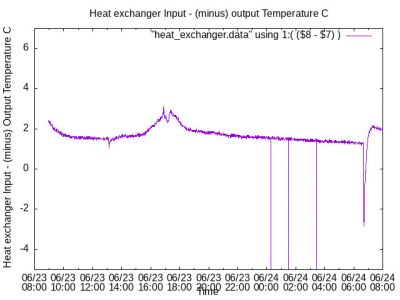Posted by: @iantelescopeA Control Tautology?
Should my Heat Pump Cycle Time be Simultaneously controlled by my Honeywell Home Thermostat AND by my Heat Pump Cycle time control?.
@derek-m ........No Derek, My Honeywell Home Thermostat cannot operate as a simple ON-OFF Thermostat.
Operating in simple ON-OFF mode would remove the clash between the Cycle Time set by the Thermostat AND the Cycle Time set by the Heat Pump itself..
I'm afraid I don't understand your philosophy.
Your heat pump should be quite capable of operating without a room thermostat, and use WC to control the IAT.
A room thermostat, if installed, should merely act as an over-temperature limit.
During the Winter heating period your heat pump should not cycle at all, though it will periodically perform a defrost cycle. It is only during milder weather conditions that it may be necessary for the heat pump to actually cycle, because it cannot lower its thermal energy output any lower without cycling. If cycling is required it should be initiated by the heat pump controller, with a room thermostat disabling the heat pump if the IAT gets too high.
@ derek-m ...."I'm afraid I don't understand your philosophy.
Your heat pump should be quite capable of operating without a room thermostat, and use WC to control the IAT."
My Samsung Heat Pump, with a second PUMP delivering HOT Water to my Radiators WILL NOT WORK without a Thermostat .!
Heat would ONLY Reach the primary ports of my Heat Exchanger!
No heat would be delivered to my Radiators!
My Primary Water circuit is , and always has been , controlled by Weather Compensation!
I did NOT Design , implement or install, my Heat Pump nor have any part of its design Philosophy !
For correct operation of your system it is necessary for the primary and secondary water pumps to operate at the same time. Without knowing exactly how your system has been configured and wired I cannot provide definitive advice. Maybe an interposing relay could be useful?
Posted by: @iantelescopeMy Samsung Heat Pump, with a second PUMP delivering HOT Water to my Radiators WILL NOT WORK without a Thermostat .!
This is because you have the second pump connected directly to the thermostat output which is incorrect sorry. The second pump should be controlled by the Samsung control box not the thermostat.
What you should have is the thermostat only wired directly to pin B22 on the Samsung controller.
You can have a relay controlled by B7 & B8 (Switched Live) to operate a second pump (because this output is limited to 500mA) if it consumes more than 100W. My secondary pump only consumes 40W so I have it directly connected and controlled by these terminals.
So in summary, your thermostat tells the Samsung controller it needs heat and the Samsung controller then operates both primary and secondary pumps along with the compressor etc.
You will need to change the wiring to the above configuration and it will then work as @derek-m has described
Regards
5 Bedroom House in Cambridgeshire, double glazing, 300mm loft insulation and cavity wall insulation
Design temperature 21C @ OAT -2C = 10.2Kw heat loss, deltaT = 8 degrees
Bivalent system containing:
12Kw Samsung High Temperature Quiet (Gen 6) heat pump
26Kw Grant Blue Flame Oil Boiler
4.1Kw Solar Panel Array
34Kwh GivEnergy Stackable Battery System
The Design Philosophy of my Heat Pump is that of Two isolated Water circuits , one controlled by by the outside Temperature and the other controlled by my heating demand.!
This would appear to be a perfectly rational design Philosophy!
This is Only my guess as to the "Design Philosophy" employed on my Heat Pump.
Nobody having admitted to Designing or building my Heat Pump !
My System :
The Primary Water Circuit:
A primary water circuit flowing from the Heat Pump itself to the input ports of my Heat Exchanger.
The Temperature of the Water within the Primary Water Circuit is controlled by Weather Compensation.
The primary Water circuit has a Grundfoss motor controlled by the Heat Pump PCB.
The Weather Compensation is Set by the Weather Compensation LCD Screen:
The Primary Water Circuit Temperature Sensor is an outdoor Thermistor attached to the rear of the Heat Pump.
The Heat Exchanger:
A Brazed Plate four Port Heat Exchanger Hydraulically isolates the Primary Water circuit from the Secondary, Radiator Water circuit.
This Hydraulic Isolation ensures that any changes to Water pressures or flow rates within the Radiators Do NOT affect the Water flow rates in the Primary Water circuit.
The Radiator, or Secondary Water Circuit:
The Water in the Secondary, Radiator Water circuit is Pumped by a second Grundfoss motor.
The Radiator Motor is Directly connected to, and controlled by, a Thermostat.
The Design Philosophy would appear to be that of Two isolated Water circuits , with one controlled by by the outside weather and the other controlled by my demand for heating!
With Two isolated Water circuits, Two Sensors are required , one to get the outside Temperature AND the other the Room Temperature.
Both my personal confidence and my confidence in this industry have been damaged.
Previously, my "Short Cycling was attributed, by Samsung-Dallium, Samsung-France and my "installer" , to the Low Water volume in my primary Water Circuit , 6 l being considered Too Little.
A Volumiser was proscribed, and fitted ..................
After two years , I personally discovered that the "Short Cycling" was not caused by the Low Water Volume , BUT, by the Honeywell Thermostat.
Both my personal confidence and my confidence in this industry have been damaged.
I CAN Fit Yet another relay ..................but am loath to repeat the Buffer tank fiasco ...........
@iantelescope I understand how you are feeling and that is why @derek-m and myself are trying to help you hopefully get a functioning system for this winter 🙂
However you need to take a deep breath and start looking at one thing at a time with our help and hopefully we will get there but you need to pluck up the courage to make some changes to your system design my friend. One principle I have always worked to (and you have probably heard it) is the KISS principle, Keep It Simple Silly which means stripping the system back to basics. If later we cannot get adequate flow rates in your secondary circuit then we may have to introduce buffers etc but I feel we are not there yet 🙂
There has been some bad advice along the way but you need to put that in the past and look forward.
So, to enable @derek-m philosophy to work you need to move the control of your second water pump from the thermostat to the terminals I have mentioned so that the Samsung controller can control both primary and secondary water pumps together. Once you have done this you can change the thermostat out for a basic one or even just put a manual switch in its place to apply a permanent 240V to the B22 terminal and your heat pump will run continuously (although you will loose the ability of set back temps and timed on off control). Once we have that you will find it easier to go through the various hydraulic checks and set up. The other alternative is set the Honeywell target temperature very high e.g 30C and you will have a permanent on output from the thermostat which is the method I used when setting up my weather compensation.
However before we can address the whole control system we need to ensure the hydraulic system is working optimally, hence radiator balancing, flow rates etc need to be potentially sorted, otherwise if the heat from your pump cannot be efficiently distributed into your house where it is needed, you are always going to have cycling issues 🙁
Regards
5 Bedroom House in Cambridgeshire, double glazing, 300mm loft insulation and cavity wall insulation
Design temperature 21C @ OAT -2C = 10.2Kw heat loss, deltaT = 8 degrees
Bivalent system containing:
12Kw Samsung High Temperature Quiet (Gen 6) heat pump
26Kw Grant Blue Flame Oil Boiler
4.1Kw Solar Panel Array
34Kwh GivEnergy Stackable Battery System
Why Should I Use Relays when my PWM Grundfoss motors are Available and Working?
Why does Samsung allow the option of either PWM (Case 1) OR RELAY (Case 2) Motor Control?
Really....Relays in the Twenty First Century?
Why, in the Twenty first century, are Samsung using , advocating, and installing Relays?
Relays are electrically noisy, Sparking mechanical devices with a limited lifespan!
If we Must use Relays why not Solid State relays ?
Many thanks , to both @technogeek and @derek-m for your help and understanding.
Separate, and independent , operation of my Secondary Radiator Grundfoss Motor from my Primary Grundfoss Motor:
An initially , somewhat mystified, visiting French SAMSUNG demonstrated the continued operation of the Primary Grundfoss Motor with a stationery secondary Motor , explaining that reducing outside Temperatures were causing Heat storage within the Primary Water circuit. ( then including the 50 l Buffer tank).
On increasing the required Room Temperature, using the room Thermostat , the Secondary Motor started , releasing the heat stored within the Buffer into the Radiator Circuit.
Separate , and independent , Motor operation would not be possible with both motors connected in Parallel.
"Octopus Cosy operation and the "S" shaped control curve"
I use Octopus Cosy to limit Electrical consumption to periods with cheap tariffs , subsequently releasing Energy during Expensive periods.
I therefore need the Thermostat Time and Temperature Controls .
This operation produces the gentle "S" shaped curve as demonstrated by "Heat-geeks " in their YouTube Videos.
Posted by: @iantelescopeWhy Should I Use Relays when my PWM Grundfoss motors are Available and Working?
Why does Samsung allow the option of either PWM (Case 1) OR RELAY (Case 2) Motor Control?
Really....Relays in the Twenty First Century ?
If my memory serves me correctly, you currently have one Grundfoss motor in your primary water circuit controlled by your Samsung control box and a second Grundfoss motor in your secondary water circuit which is controlled by your thermostat hence this is why your second Grundfoss motor is dependent on you having a thermostat.
What you need to aim for is both Grundfoss motors being controlled from your Samsung controller. The second water pump output (B8 & B7) on the Samsung controller, which you will connect to, is only capable of running a fixed speed motor of less than 100W consumption. If your Grundfoss motor consumes more than 100W you need to put a relay in otherwise you will damage the Samsung controller board. I currently have a fixed speed Wilo pump which consumes 40W directly connected to those terminals which does not need a relay however as I do not know the power consumption of your Grundfoss motor I am advising (as reference to the manual) you to use a relay. If you are confident the Grundfoss consumes less than 100W you should be fine without a relay.
Regards
5 Bedroom House in Cambridgeshire, double glazing, 300mm loft insulation and cavity wall insulation
Design temperature 21C @ OAT -2C = 10.2Kw heat loss, deltaT = 8 degrees
Bivalent system containing:
12Kw Samsung High Temperature Quiet (Gen 6) heat pump
26Kw Grant Blue Flame Oil Boiler
4.1Kw Solar Panel Array
34Kwh GivEnergy Stackable Battery System
Since you seem reluctant to make physical changes to the wiring of your system you could try operating in the following manner.
Set your Honeywell room thermostat to 2C above the desired temperature. Adjust the WC curve to achieve the desired IAT.
In colder weather conditions the heat pump and primary water pump, along with the secondary water pump should be operating almost continuously.
In milder weather conditions the heat pump and primary water pump will operate periodically, whilst the secondary water pump will operate continuously unless switched off by the room thermostat due to increased IAT.
Delta_t increase resulting from water flow rate Reduction on BOTH the Primary and Secondary Water Circuits.
Here is the Delta_t across the Primary Heat Exchanger ports on 24th June, with unrestricted Water Flow rates on Both Primary & Secondary Water circuits :
Here is the Delta_t across the Primary Heat Exchanger ports on 1st July, with Reduced and controlled Water Flow rates on Primary and Secondary Water Circuits :
Note the increase in Delta_t from ~2 C to over ~10 C !!
Water flow rate reduction was achieved using an Arduino sourcing a Pulse Width Modulated Signal.!
My Arduino produced PWM Signal, controlling the Primary Grundfoss Motor, is a function of the primary Delta_t itself!.
My Arduino produced PWM Signal, controlling the Secondary Grundfoss Motor, is a fixed 125 us Signal.
The French Samsung Engineer "Thought that my principal problem was caused by the Excessive Water flow rates in Both Water Circuits".
Conclusions:
The Water Flow rates in BOTH Water Circuits CAN be effectively , and safely, be varied using the Motor PWM Inputs.
Reducing the Water Flow rates greatly increases the Delta_t across the Heat Exchanger Input and Output ports!
Switching and Water Flow rates can be Safely controlled by the PWM inputs rather than Power Relays!
- 26 Forums
- 2,426 Topics
- 55.1 K Posts
- 235 Online
- 6,104 Members
Join Us!
Worth Watching
Latest Posts
-
RE: Is it normal to use power from the grid when running off the battery?
@batpred I may be asking you for more info in how you h...
By JohnnyB , 53 minutes ago
-
RE: Recommended home battery inverters + regulatory matters - help requested
@johnnyb The noise of the Solis is nothing very sign...
By Batpred , 60 minutes ago
-
RE: Is my Samsung gen6 outside air temp sensor missing a sheath/sleeve?
@papahuhu Yes, good information is often hard to find, ...
By Old_Scientist , 1 hour ago
-
RE: R290 and Foundation Air Bricks
Professional risk assessment (inc some common sense) ...
By ASHP-BOBBA , 2 hours ago
-

RE: The good, the bad and the not that great – my heat pump installation
@toodles ahhh no trouble yeah probably won't mess with ...
By Burtis , 2 hours ago
-
RE: Daikin Wireless Thermostat
@bash we have mostly south facing rooms which would ove...
By Judith , 3 hours ago
-

RE: Post-Traumatic Heat Pump Stress Disorder
Some more examples of those that really should be benef...
By Jeff , 4 hours ago
-
RE: Installer Fitted 9kW Instead of 11kW Heat Pump and Changed MCS Paperwork - What do I do?
I've now had an interesting email from a Complaints Res...
By MairiA , 6 hours ago
-

RE: Reliable, easy to use home battery options
Correct. LiFePO₄ cells mustn't be charged if their te...
By Transparent , 6 hours ago
-

RE: Water outage in the the south-east
Indeed!Any contamination in the well water would be tra...
By Transparent , 8 hours ago
-
RE: Solis inverters S6-EH1P: pros and cons and battery options
I hear some cases of apparent misconfiguration of inver...
By Batpred , 8 hours ago
-
Are split ASHPs with R290 refrigerant coming soon?
Question. Are there any (or likely to be in the near t...
By iotum , 10 hours ago
-

RE: Setback savings - fact or fiction?
Indeed. In many ways, a defrost is a setback, with the ...
By cathodeRay , 10 hours ago
-
RE: Heat pump not reaching flow temperature
The good news is that it leaves no excuse if it doesn't...
By JamesPa , 11 hours ago
-
RE: How to use my Hanchu battery storage for home without it feeding back into the grid?
@countryman-helmsley In that case is there a button ...
By IRMartini , 11 hours ago
-
RE: Ideal HP290 14kW ASHP - how to optimise
Great. It’s not bad is it, though I agree it may repres...
By Davesoa , 13 hours ago
-
RE: Ecodan Pump Issues… Circulation pump turns off when heat pump compressor turns off
@f1p apologies, you are absolutely correct
By Patch321 , 13 hours ago
-

RE: Samsung E101 Error Message and my ASHP Efficiency
@johnnyb amazing that the our forum is serving its purp...
By Mars , 1 day ago
-
Best option for controller upgrade? - Grant Aerona
Fairly new heat pump owner - Grant Aerona 3 10kw - and ...
By Topher , 1 day ago
-

Just a brief update to keep things transparent. Secti...
By DREI , 1 day ago








